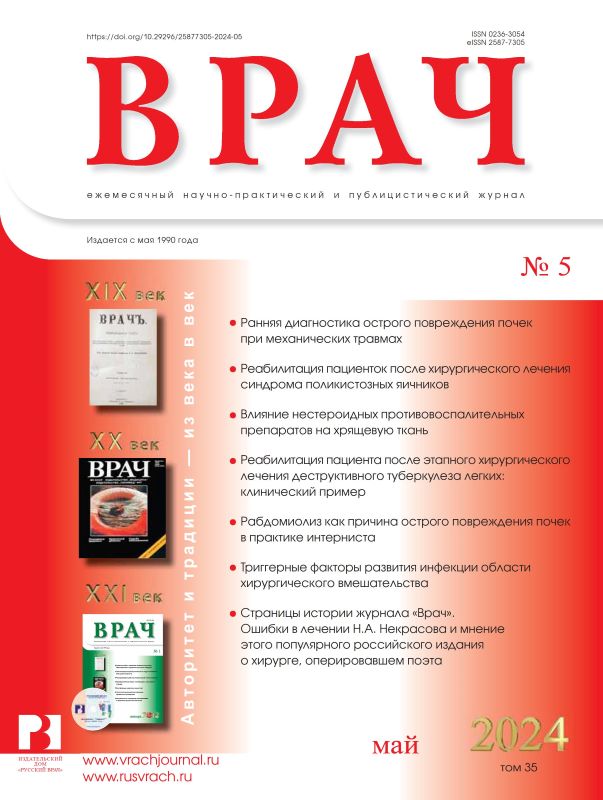Нефропротективные возможности витамина D у пациентов с диабетической нефропатией
- Авторы: Лихачева А.П.1,2, Агранович Н.В.1, Классова А.Т.1, Анопченко А.С.1,2
-
Учреждения:
- Ставропольский государственный медицинский университет Минздрава России
- Ставропольский краевой клинический многопрофильный центр
- Выпуск: Том 35, № 5 (2024)
- Страницы: 73-78
- Раздел: Из практики
- URL: https://journals.eco-vector.com/0236-3054/article/view/633316
- DOI: https://doi.org/10.29296/25877305-2024-05-13
- ID: 633316
Цитировать
Полный текст
Аннотация
Рост числа больных диабетической нефропатией и малая эффективность стандартной нефропротективной терапии диктуют необходимость поиска новых, более эффективных методов лечения пациентов данной группы.
Цель. Изучить нефропротективные свойства витамина D у пациентов с диабетической нефропатией.
Материал и методы. Проведено анкетирование и исследование общего анализа крови, общего анализа мочи, уровня 25-гидроксивитамина D, креатинина, мочевины, общего белка, глюкозы, гликированного гемоглобина, общего кальция, паратиреоидного гормона, интерлейкина (ИЛ) -6, -8 и гомоцистеина в крови у 200 пациентов с сахарным диабетом (СД) и хронической болезнью почек (ХБП) и 40 условно здоровых лиц в возрасте от 18 до 89 лет, подписавших добровольное информированное согласие. Все пациенты разделены на 3 исследуемые группы: основная группа – пациенты с СД и ХБП, получавшие терапию витамином D; группа сравнения – пациенты с СД и ХБП, не получавшие терапию витамином D; группа контроля – условно здоровые лица.
Результаты. У всех пациентов с СД, независимо от длительности течения заболевания, выявлены признаки ХБП. Содержание витамина D в крови также было снижено у всех больных. Доказана прямая и сильная корреляционная связь уровня витамина D с показателем скорости клубочковой фильтрации (СКФ) и обратная сильная корреляционная связь с концентрацией креатинина в крови обследованных. Достоверно установлено положительное влияние витамина D на показатели паратиреоидного гормона, ИЛ6, -8 и гомоцистеина.
Заключение. Назначение оптимальной дозировки витамина D пациентам с диабетической нефропатией на протяжении 6–12 мес способствует снижению уровня креатинина в крови, улучшению показателей СКФ, повышению содержания 25-гидроксивитамина D и снижению провоспалительных цитокинов, что положительно сказывается на функциональном состоянии почек и позволяет замедлить или предотвратить развитие и прогрессирование диабетической нефропатии у больных СД.
Полный текст
Об авторах
А. П. Лихачева
Ставропольский государственный медицинский университет Минздрава России; Ставропольский краевой клинический многопрофильный центр
Автор, ответственный за переписку.
Email: annarebiy@yandex.ru
ORCID iD: 0000-0001-7025-4231
Россия, Ставрополь; Ставрополь
Н. В. Агранович
Ставропольский государственный медицинский университет Минздрава России
Email: annarebiy@yandex.ru
ORCID iD: 0000-0002-3717-7091
доктор медицинских наук, профессор
Россия, СтавропольА. Т. Классова
Ставропольский государственный медицинский университет Минздрава России
Email: annarebiy@yandex.ru
ORCID iD: 0000-0002-8625-812X
Россия, Ставрополь
А. С. Анопченко
Ставропольский государственный медицинский университет Минздрава России; Ставропольский краевой клинический многопрофильный центр
Email: annarebiy@yandex.ru
ORCID iD: 0000-0002-9308-6784
кандидат медицинских наук, доцент
Россия, Ставрополь; СтавропольСписок литературы
- IDF Diabetes Atlas, 10th ed., 2021. URL: https://diabetesatlas.org/
- Муркамилов И.Т., Айтбаев К.А., Фомин В.В. и др. Диабетическая нефропатия: распространенность и факторы риска. Вестник ВолгГМУ. 2021; 1 (77): 3–11 [Murkamilov I.T., Aitbaev K.A., Fomin V.V. et al. Diabetic nephropathy: prevalence and risk factors. Vestnik VolgGMU. 2021; 1 (77): 3–11 (in Russ.)]. doi: 10.19163/1994-9480-2021-1(77)-3-11
- Шестакова М.В. Сахарный диабет и хроническая болезнь почек: возможности прогнозирования, ранней диагностики и нефропротекции в XXI веке. Терапевтический архив. 2016; 6: 84–8 [Shestakova N.V. Diabetes mellitus and chronic kidney disease: possibilities of prediction, early diagnosis, and nephroprotection in the 21st century. Therapeutic archive. 2016; 6: 84–8 (in Russ.)]. doi: 10.17116/terarkh201688684-88
- Maestroni S., Zerbini G. Diabetic Nephropathy–Research. Microvascular Disease in Diabetes. 2020; 97–109. doi: 10.1002/9781119309642.ch8
- Kidney Disease: Improving Global Outcomes (KDIGO) Diabetes Work Group. KDIGO 2022 Clinical Practice Guideline for Diabetes Management in Chronic Kidney Disease. Nephrology. 2022; 102 (5S): 1–127. doi: 10.1016/j.kint.2022.06.008.
- Клинические рекомендации. Хроническая болезнь почек (ХБП). Нефрология. 2021; 25 (5): 10–82 [Clinical recommendations. Chronic kidney disease (CKD). Nephrology. 2021; 25 (5): 10–82 (in Russ.)]. doi: 10.36485/1561-6274-2021-25-5-10-82
- Клочкова Е.В., Толмачева А.А., Чернова Н.Н. и др. Диабетическая нефропатия и хроническая болезнь почек при сахарном диабете 2 типа. Сибирское медицинское обозрение. 2019; 5: 29–32 [Klochkova E.V., Tolmacheva A.A., Chernova N.N. et al. Diabetic nephropathy and chronic kidney disease in type 2 diabetes. Siberian Medical Review. 2019; 5: 29–32 (in Russ.)]. doi: 10.20333/2500136-2019-5-29-32
- Лихачева А.П., Агранович Н.В., Классова А.Т., и др. Уровень витамина D у больных сахарным диабетом в сочетании с хронической болезнью почек. Нефрология. 2021; 25 (6): 81–6 [Lichacheva A.P., Agranovich N.V., Klassova A.T. et. al. Vitamin D levels in patients with diabetes mellitus in combination with chronic kidney disease. Nephrology. 2021; 25 (6): 81–6 (in Russ.)]. doi: 10.24884/1561-6274-2021-25-6-81-86
Дополнительные файлы







